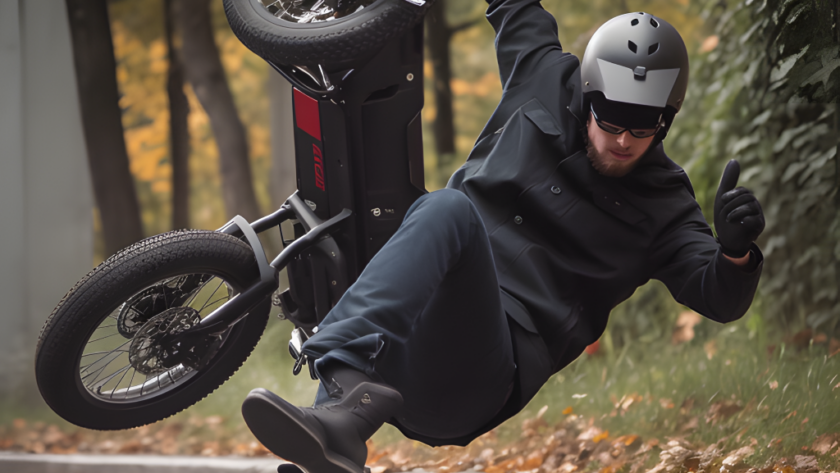Introduction to the topic of e-bikes and their benefits
E-bikes, also known as electric bikes, are quickly becoming a popular alternative to traditional bicycles. They offer riders the ability to go farther and faster, with less effort. An e-bike is equipped with an electric motor or battery-powered assist that helps the rider propel along. This helps those who struggle to keep up with the pace of other cyclists, those who have a longer commute than usual, or those who simply want to cover more distance without tiring out quickly.
In addition to riding farther and faster, there are many other benefits of using an e-bike. These include:
- E-bikes can help people save money on fuel costs since they don’t require gasoline
- E-bikes help reduce air pollution since they don’t release any emissions
- E-bikes provide riders with a greater sense of security since they can easily keep up with traffic in urban areas
- E-bikes are often easier to store than traditional bikes
- E-bikes can be used for a variety of purposes, from commuting to recreational activities
E-bikes offer many advantages over traditional bicycles, but it is important to understand how these bikes differ from one another before making a decision. By understanding the differences between traditional bicycles and e-bikes, you can make an informed decision about which type of bike best suits your needs.
Understanding the Differences Between Traditional Bicycles and E-bikes
E-bikes and traditional bicycles have some distinct differences. Knowing these differences is important for choosing the bike that is right for you. Whether you are looking for speed, safety, convenience, or a combination of all three, it is essential to understand the distinguishing features of traditional bikes and e-bikes.
Traditional bicycles are powered solely by the rider’s pedaling effort. E-bikes, on the other hand, are partially powered by an electric motor. Both types of bikes can travel the same distance, but the e-bike requires less effort to reach the same speed as a traditional bike.
Another key difference between e-bikes and traditional bicycles is their design features. E-bikes tend to have heavier and sturdier frames than traditional bikes, along with larger and sturdier wheels. This makes them better suited for navigating difficult terrain, such as going off-road and climbing hills. Additionally, e-bikes have their electric motor mounted in different places on the frame, depending on the design. Some have their motor located in the center of the frame, while others may have it located near the bottom bracket.
In addition to their power source and frame design, e-bikes come with additional features that create a safer and more convenient ride. For example, many e-bikes come equipped with a throttle that allows the rider to take off quickly and easily, even if they are not currently pedaling. They also come with more powerful brakes than traditional bikes, making them easier to stop quickly. Furthermore, e-bikes often come with lights and other safety features that make riding in dark or low-light environments safer.
Finally, e-bikes are often equipped with extra cargo space in the form of a basket, panniers, or racks. This can be very helpful for commuters who need to carry items to and from work, school, or other destinations.
As you can see, there are several important differences between traditional bikes and e-bikes. Knowing these differences is key to deciding which bike best meets your individual needs and desires.
E-bikes are quickly gaining in popularity, and for good reason. Not only can they take you farther distances with less effort, but they also come with added safety features to keep you safe on the roads.
When it comes to e-bikes, there are a range of features you should consider looking for when purchasing one. These range from the more basic features – such as lights and reflectors – to more advanced features which are becoming increasingly common.
One of the most important safety features for an e-bike is a braking system. There are two main types – rim brakes, where the brake pads squeeze the wheel rims, and hydraulic disc brakes, where hydraulic fluid is used to actuate the brakes. In terms of stopping power, disc brakes usually provide superior stopping power, as they allow for more modulation and control of speed.
Another key safety feature is visibility. Not only do e-bikes tend to travel at higher speeds than traditional bikes, but they are also often heavier and harder to spot. For this reason, it’s important to look for an e-bike with plenty of reflectors or even headlights. Many modern e-bikes will come with lighting already installed, but it’s always worth double checking.
Some more advanced features include anti-lock braking systems, traction control and crash detection technology. Anti-lock brakes help to reduce the chances of skidding, while traction control helps to prevent the wheels from spinning out of control. Crash detection technology is a relatively new development and typically uses sensors to detect if the rider has been involved in a crash, automatically alerting emergency services.
Finally, it is worth noting that many e-bikes now come with electric motor cutoff switches, typically built into the handlebars. These cut off power to the motor when activated, making them a useful safety feature in certain scenarios.
When shopping for an e-bike, it’s important to remember that not all models come with the same safety features. Be sure to read up on the different safety features available and make sure to choose an e-bike that suits your individual needs.
Reasons why e-bikes are beneficial for commuters
Electric bikes are becoming increasingly popular as a commuting option. Every day, more and more people are hopping on e-bikes to make their daily commute more efficient and enjoyable. There are several reasons why e-bikes make great commuter options.
Easier Commute
The most obvious benefit of riding an e-bike is that it’s easier than riding a traditional bike. With an electric motor assisting you, you can easily go further and faster compared to a regular bicycle. Also, you can ride with less effort, meaning that you don’t get too tired even after a long ride.
Faster Journey
Since you can reach faster speeds on an e-bike, you can cover more distance and get to your destination quicker. Even when you’re stuck in traffic, you can still make progress as you can maneuver around cars and other obstacles with ease.
Cheaper than Public Transport
Another advantage of riding an e-bike is that it’s much cheaper than using public transport. Not only do you not have to worry about buying tickets for buses and trains, but you also save money on petrol and parking fees. Plus, you are getting a form of exercise at the same time.
Environmentally Friendly
Finally, e-bikes are environmentally friendly. Unlike conventional vehicles, they don’t produce any emissions, which makes them much better for the environment. As a result, you can reduce your carbon footprint while getting around.
For commuters, e-bikes offer numerous benefits. From easier rides to faster travel times, there are many advantages to switching to an electric bike for your daily commute. Plus, you can help protect the environment while saving money at the same time.
What Makes E-Bikes More Safe Than Traditional Bicycles?
E-bikes offer a number of advantages over traditional bicycles that make them safer for riders. For starters, the electric motor offers riders more power and speed than a bike propelled by human energy alone. This allows riders to navigate roads and places they wouldn’t have been able to access on a traditional bicycle. In addition, many e-bikes come with increased visibility features, such as LED headlights, reflective tires, and even built-in turn signals that are designed to make it easier for riders to be seen by drivers.
Another factor that makes e-bikes safer than traditional bicycles is the brakes. While traditional bike brakes are often finicky and require some degree of maintenance, e-bike brakes are typically far superior. Most e-bikes come with disc brakes, which provide excellent stopping power and are much easier to maintain. Furthermore, as the majority of e-bikes run on internal batteries, the likelihood of an accident due to an unexpected mechanical failure is greatly reduced.
Finally, many e-bike models come with suspension systems that can help make riding much more stable. Suspension systems absorb shock from bumps and uneven terrain, making the ride much smoother and safer. Some e-bikes also come with adjustable seats and handlebars, so riders can customize their fit and find the optimum position for their body size and height.
All in all, e-bikes offer several advantages that make them significantly safer than traditional bicycles. E-bikes offer more power and speed, as well as features like disc brakes, suspension systems, and adjustable seats and handles that make riding more comfortable and reliable. With these advantages, e-bike riders can feel confident that they are taking all the necessary precautions to stay safe on the road.
The Case for More Careful Rider Behavior on E-Bikes
E-bikes have sparked a renewed interest in cycling, as they give users the advantage of power assist when riding. With this newfound boost comes an added responsibility of taking greater care while on the road.
Unlike traditional bikes, e-bikes are usually heavier and come with greater speeds. This can lead to an increased risk of serious injury in the event of an accident. As such, riders should be more vigilant when out on their e-bikes.
- Be aware of your surroundings and never assume that other road users are aware of you.
- Always wear a helmet and make sure your bike is properly equipped with lights and reflectors.
- Follow the regular traffic rules and abide by any local regulations around e-bikes.
- Ride in a predictable and consistent manner, avoiding any sudden or erratic maneuvers.
- Watch for potential hazards such as potholes or loose gravel.
- Be aware of the speed you’re traveling at and stay within the recommended limits.
By taking more care while on their e-bikes, riders can take the necessary steps to improve their safety and reduce their risk of injury.
Regulations Around Safety For Electric Bikes
Electric bikes are becoming increasingly popular, but to ensure that electric bike riders are safe, there are some regulations in place. The primary regulations concern the speed of the electric bike and the power that it is permitted to produce.
The maximum power an electric bike can generate is usually limited to 250 W in most countries. Some countries have different regulations in place, such as in the US where the maximum power output is limited to 750W. Additionally, the maximum speed of an electric bike is usually 25 kph or 15mph, though this can vary from country to country.
Aside from the power and speed limits, the safety of the rider is considered with the design of the bike itself. For example, electric bikes are typically built with wider handlebars and brakes than traditional bicycles to ensure greater stopping power, as well as wide tires for better stability. Additionally, all electric bikes must have an efficient braking system to ensure that riders can safely stop at any given time.
In some countries, electric bikes must also have lights and reflectors, similar to those required on a traditional bicycle. This is both for the safety of other cyclists and pedestrians, but also to increase visibility for the electric bike rider. Lastly, all electric bike riders must wear an approved helmet for added protection.
Overall, the regulations around safety for electric bikes are designed to ensure that all riders are able to stay safe and enjoy their ride. By adhering to the regulations and best practices, electric bike riders can ensure that they will always be riding safely.
Analyzing Recent Data Sets Around Safety Rates Between Electric and Traditional Bike Riders
With the emergence of electric bikes as a popular mode of transportation, safety concerns among riders and other road users are common. But are electric bikes safer than traditional bicycles? To answer this question we need to examine recent data sets on bike accidents
Recent studies based on bicycle accident data collected in various cities are showing that e-bike riders are at a slightly lower risk of sustaining injuries in comparison to traditional bike riders. The studies attribute this to the fact that electric bikes allow riders to maintain a consistent speed, which can be beneficial in traffic. Additionally, the extra power provided by electric motors means that riders don’t have to ride as hard to maintain their speed and are often able to react faster in case of an emergency.
However, it is important to remember that electric bikes still require skill and experience from operators. Electric bikes are heavier than traditional bikes and have a higher center of gravity, making them more difficult to maneuver. This means that inexperienced riders may be more prone to accidents and injuries even if they are riding an electric bike.
It is also important to factor in other safety measures when evaluating the safety of electric bikes versus traditional bicycles. For example, the infrastructure design of a city has a major impact on bicycle safety. Cities with protected bike lanes or dedicated bike paths tend to have lower rates of bicycle accidents, whereas those without such infrastructure have higher accident rates.
In conclusion, recent data sets suggest that electric bikes are slightly safer than traditional bikes when it comes to accidents. However, this does not mean that electric bikes are risk-free. Riders still need to be aware of their surroundings and exercise caution when operating an electric bike, just as they would with any other vehicle.
Safety Tips for E-Bike Riders
Riding an e-bike is a great way to get around, but just like with any other mode of transportation, safety is paramount. Follow these tips to stay safe while riding your e-bike:
- Always wear a helmet and other protective gear such as gloves and elbow/knee pads.
- Always ride within the limits of your own abilities. If you are unfamiliar with riding an e-bike, practice in a safe environment before attempting to ride on busy roads with other traffic.
- Be aware of the speed limit and always try to stay within the posted speed limit when riding an e-bike.
- When dealing with turns and intersections, slow down and proceed with caution. Always check for traffic and obey traffic signals.
- Be aware of the conditions of the road, as potholes and other road hazards can be easily overlooked when biking at higher speeds.
- Be aware of blind spots when passing another rider or vehicle. Always remember to use hand signals when indicating a turn.
- Be visible to others. Wear reflective clothing, install front and rear lights, and attach a bell or horn to your bike to alert others when you are coming.
- Securely attach all items that you are carrying on your bike, so they do not interfere with your ability to ride safely.
- Perform regular maintenance on your bike as described in the owners’ manual to ensure everything is in good working order.
By following these safety tips, you can be sure to enjoy your e-bike ride in a safe and responsible manner.
Discussing bicycle infrastructure designs that promote the safety of e-bike riders
Bicycle infrastructure is an important factor in promoting the safety of e-bike riders. Designing roads, paths, and other infrastructure for bikes can help to reduce the risk of harm to both e-bike users and traditional bike riders.
Infrastructure designed with e-bikes in mind should include special lanes that are wider than regular biking lanes, to allow for the larger size and speed of e-bikes. These lanes should also be kept clear of debris and other hazards that could cause a crash.
In addition, infrastructure should be designed with e-bikes in mind when it comes to intersections. As e-bikes move faster than traditional bikes, they need extra time to get to and across intersections. This can be achieved through the addition of bike boxes and early start signals that allow e-bike riders to cross intersections safely and quickly.
Finally, infrastructure should be designed with visibility in mind. E-bike riders should be provided with clearly marked lanes, signage, and street markings that will make them more visible to drivers. This can help to reduce the risk of drivers not seeing them in time to slow down or stop and avoid a collision.
Designing infrastructure with the safety of e-bike riders in mind can help to reduce the risk of harm to both e-bike users and traditional bike riders. With the right infrastructure design, both groups can enjoy a safe and enjoyable cycling experience.
Measuring Bike Safety in Different Cities
Measuring bike safety in different cities is an important part of understanding the safety benefits and risks associated with e-bikes versus traditional bicycles. Each city has its own unique set of factors that contribute to how safe or dangerous it is to ride a bike, including the infrastructure and availability of bike lanes, local laws, and the attitude and behavior of drivers. By looking at the data and trends in different cities, we can draw some general conclusions about the relative levels of safety for each type of bike.
One thing to consider is the number of bike accidents that occur in each area. Studies have shown that most bike accidents happen in urban areas, due to the larger amount of traffic and higher speed of vehicles. Looking at these numbers can give us insight into the general level of risk for bike riders.
Another factor to take into account is the level of investment in bike safety initiatives by local governments. If a city provides more funding for bicycle infrastructure and safety initiatives, this could reduce the number of bike accidents overall. Additionally, there may be other bike safety laws in place that can make it easier or harder for bike riders to stay safe.
In addition to the data and statistics available, it’s important to understand how bike riders themselves perceive the risk of biking in their area. Surveys can be used to gauge how safe or unsafe riders feel when they are on their bicycles. This can be a useful way to quantify the experience of riding a bike in a particular city, as well as provide insight into how safe riders think they are when riding their e-bike or traditional bike.
By looking at the data from surveys and accident reports, along with the infrastructure investments made by different cities in bike safety, it is possible to draw some general conclusions about the relative levels of safety for e-bikes versus traditional bicycles. With this information, bikers can make more informed decisions about the type of bike they choose to ride in their city.
Conclusion
Based on the evidence it appears that e-bikes are safer than traditional bikes for riders. This can be attributed to their range of safety features, reduced speed and weight, as well as an increased understanding of the dangers associated with riding a bike. These advances in technology have enabled more people to experience the joys of cycling, making it more accessible for riders. Regulations and infrastructure design also play an important role in maintaining safety for e-bike riders.
When considering safety, it is important to remember that it is not only the type of bicycle that can influence the risks associated with cycling, but also the rider’s behaviour. It is the responsibility of cyclists to ride safely and responsibly. Even if they are using an electric bike, they should be aware of their surroundings and follow road rules and regulations.
However, looking at the data, it is clear that e-bikes are generally safer than traditional bikes. They have reduced speeds, greater safety features and increased awareness of riding safety. There is also potential for infrastructure designs to better promote the safety of e-bike riders, making cycling a safer and more enjoyable form of transportation for all.
FAQs on E-Bikes and Traditional Bikes Safety
- Q:Are E-Bikes safer than traditional bikes?
A: Yes, E-bikes are generally safer than traditional bikes due to the addition of features such as motor assist, better brakes, and improved traction control. This makes e-bikes more stable and safe for riders in challenging road conditions. - Q:What benefits do e-bikes offer to commuters?
A:E-bikes offer several advantages for commuters such as improved speed and efficiency, allowing riders to cover longer distances in a shorter amount of time. Additionally, e-bikes are also generally easier and more comfortable to ride than traditional bicycles since they offer motor assist. - Q:What safety features are available for e-bikes?
A: Modern e-bikes come equipped with a variety of safety features such as integrated lights, reflective detailing, and improved braking systems. Some e-bikes also have built in GPS tracking which provides an extra layer of security for riders. - Q:What regulations are there around safety for electric bikes?
A: Most countries have specific regulations or laws regarding the use of electric bikes. These include rules around helmet usage, speed limits, and other safety related protocols. It is important for riders to familiarize themselves with local rules before riding an e-bike. - Q:Are there any bike infrastructure designs that promote safety for e-bike riders?
A: Designing a bike infrastructure that is suitable for different types of riders is important for encouraging safe cycling. Examples of bike infrastructure designs that consider the needs of e-bike riders include dedicated bike lanes, well lit pathways, and paths that are free of debris. - Q:What data sets exist providing information on the safety rates between electric and traditional bike riders?
A: Several international or national organizations compile data sets around transportation safety and ridership statistics. These data sets can provide useful information on the safety rates of electric and traditional bike riders. - Q: What safety tips should be considered when riding an e-bike?
A:E-bikes riders should practice the same safety principles as traditional bike riders. These include wearing a well fitted helmet, obeying traffic laws, and being visible and alert to other vehicles and pedestrians on the road.
comments: 0




